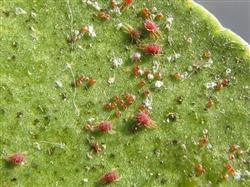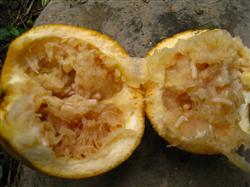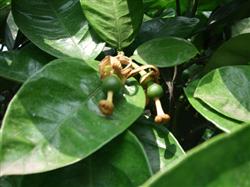Which diseases and insect pests should be controlled when planting Fuchuan navel orange?

Which diseases and insect pests should be controlled when planting Fuchuan navel orange? Please give an introduction and control methods the following is the introduction and control methods of common diseases and insect pests of navel orange for reference: rust wall lice: during the young fruit period from late May to early June, spraying starts when there are 5 insects on the fruit surface, and sprays once every 15 days, spraying 3 times in a row, and spraying twice from July to September. The medicament has 40% isocarbophos 1000 Mel 2000 fold solution, tin triphosphate 1500 Mel 2000 fold solution, propargite 3000 Mel 5000 fold solution, Dyson zinc 800 Mel 1000 fold solution. Prevention and treatment of canker, thoroughly erase summer shoots, cut off diseased branches and leaves. Focus on spray prevention and control after summer rain, you can choose 0.5: 0.5: 100 Bordeaux solution plus 2% washing powder, 77% can kill 600 rain 800 times liquid, fruit disease gram 1000 rain 1200 times liquid or add rice 600 rain 800 times liquid. Fourth, navel orange pest control [occurrence regularity] the pathogen overwintered in the diseased part, and the optimum temperature for growth was 20 mi 30 degrees. From spring to autumn, when the environmental conditions were suitable, the disease department continued to escape pathogens and spread them closely with the help of the contact between wind, rain, insects and cross branches. Long-distance transmission depends on diseased seedlings, scions and fruits. Bacteria can invade the young tissue from stomata, lenticels and water pores, and invade the mature tissue from the wound. The disease often occurs seriously after high temperature and rainy weather or after Taiwan wind and rain. [prevention and control methods] (1) strictly implement the quarantine system. (2) cultivate disease-free seedlings. (3) reduce the source of orchard disease. The bio-organic compound fertilizer containing actinomycetes is often used in winter fertilizer or spring fertilizer. Diseased leaves, diseased branches and fruits are removed and burned in summer, autumn and winter, which is an effective measure to control canker in production. (4) strengthen the prevention and control of leaf miner and other insect pests, reduce the wounds of branches and leaves, avoid the invasion of germs, and erase the irregular shoots. (5) Chemical control. The medicine was sprayed once at each time when the tender shoots were drawn out of 3 cm, when the leaves were spreading and when the leaves turned green. The medicament can be selected as follows: 80% Dasheng 600x liquid, agricultural streptomycin 600m / ml 1000 units / ml plus 1% alcohol, 77% can kill 1000 times solution, 30% copper oxychloride 600Mel 800 times solution. Anthrax [pathogen] the pathogen of anthrax is a fungus of the subphylum. The disease is the main disease in nursery, orchard and fruit storage period. it harms tender leaves, shoots, flowers and fruits, and causes fallen leaves, withered shoots, fruit and fruit rot during storage. [symptoms] the disease is mainly damaged leaves, which can be divided into two types: acute type and chronic type. Acute type is common in nursery. Acute anthracnose is ferocious and spreads rapidly and is common in high-temperature and humid nurseries at the beginning of summer. After the young leaves were infected before turning green, the leaf tip or leaf edge initially showed dark green water-stained plaques, the disease spot expanded rapidly, and the edge was not obvious. Chronic anthracnose is common in adult trees, which can cause a large number of fallen leaves, branches dry up from top to bottom, and the boundary between the sick and healthy parts is obvious. [incidence regularity] the pathogen overwintered in the diseased part as conidia or mycelium, and the optimum temperature for growth was 21 ~ 28 degrees. The disease was especially serious after the high temperature and rainy early summer rainstorm. New shoots before turning green leaves, partial application of nitrogen fertilizer, weak trees, overripe or cut fruits are easy to be infected with the disease. [control methods] the applicable periods of control are shoot emergence, flowering, fruit growth, after strong wind and rainstorm and fruit near maturity. The main results are as follows: (1) strengthen the management of fertilizer and water and improve the disease resistance of trees. (2) clear the garden thoroughly in winter, cut off and burn diseased branches and leaves, and eliminate the source of overwintering disease. (3) spraying prevention and treatment. Spray is needed when the incidence of branches, leaves, flowers or fruits is 4-5%. If it is acute, spray is the symptom. Spray one time in the short period of each extraction and two times in the young fruit stage. You can choose 0.5% equivalent Bordeaux solution or 70% Chlorothalonil WP or 75% Chlorothalonil WP800-1000 fold solution or 50% carbendazim WP600 solution or mancozeb WP600-800x liquid or 25% Spock EC (emulsion) / WP2000 multiple solution or 47% carbendazim 800-1000 times 50% methamphetamine WP500~700 or 77% copper hydroxide WP600 times or 30% Wang Copper SC600 times, etc. The main pest control symptoms of citrus red spiders: there are many small gray spots after the leaves are damaged, the chlorophyll content is low, the photosynthesis of the leaves is weakened, the leaves lose their luster, cause fallen leaves and withered shoots, affect the tree potential, and reduce flower bud differentiation and yield. It is a common pest in navel orange producing areas in China. It pierces leaves, branches and fruit epidermis with piercing mouthparts to absorb juice and chlorophyll. Living habits: overwintering with adults or eggs. Red spiders have strong fecundity and serious generation overlap. The algebra that occurs in a year has a great relationship with air temperature and rainfall. The ten-day average temperature is about 25 degrees higher, and the relative temperature is 60% 80%. There are 18 generations a year in Yizhang County, and the peak occurs twice a year, the first in April-May, and the second in September-October. Control methods: agricultural control: ① orchard reasonable intercropping and grass cultivation, orchard interplanting artichokes, hemp, etc., conducive to dry protection and proliferation of natural enemies. ② strengthens fertilizer and water management, promotes plant growth and improves its resistance to diseases and insect pests. The implementation of turning the soil, reasonable pruning, cleaning the orchard, thoroughly cleaning the garden in winter, reducing the source of overwintering insects, except the base number of overwintering insects. Biological control: ① gives priority to the use of microbial and botanical biological pesticides. ② chooses insecticides and acaricides that can kill natural enemies such as predatory mites, herbaceous banknotes and mites. Use and protect predators. There are many kinds of natural enemies of red spiders, including predatory mites, lacewing larvae, mite-eating ladybugs, six-spot thrips, parasitic bacteria and so on. A. the method of grass cultivation was adopted. B. Protect natural enemies and carry out provocative treatment. When red spiders occur in some plants, it is not necessary to spray the whole garden, only the central insect strain and its surrounding plants can be sprayed, so as to reduce the killing of pesticides to natural enemies. C, artificial breeding to release predatory mites and other natural enemies. Chemical control should carry out prediction and forecast, check insects and spray medicine, and grasp the key period of prevention and control. Pay close attention to the orchard insect situation before the leaves of spring and autumn shoots turn green. When the density of red spider reaches 50 leaves and 100 leaves, the whole orchard should be sprayed to reduce the population base before the peak, so that the first and second damage peak can not be formed. The suitable period and index for the control of citrus rust wall lice: from May to June, there were 2 leaves or fruits per field of view under 10 times magnifying glass, or the leaf back of the spring shoots of the same year was damaged; from July to October, 4 leaves or fruits were killed per field of vision under 10 times magnifying glass, or 1 fruit was found to be damaged in the orchard; or 5% leaves or fruits had rust mites. Control technology: can refer to the control method of citrus red spider. Symptoms of damage caused by citrus leaf miner: the damaged leaves were deformed and hardened, the photosynthetic efficiency decreased, and the wounds caused were easily invaded by ulcer pathogens. Curled leaves provided overwintering places for mites, scale, aphids and so on, which increased the difficulty of winter control. Also known as the drawing worm, commonly known as the "ghost symbol". The newly hatched larvae use chewable mouthparts to lift the epidermis of tender leaves and stems, and eat the mesophyll and tender phloem cortex inside, forming a curved silver-white insect track. Living habits: overwintering with pupae and a very small number of larvae on leaves, the mortality rate after overwintering is often more than 98%. Generally, about 10 generations occur every year, and the generations overlap seriously. Spring shoots often begin to suffer in May. The damage to summer and autumn shoots is the most serious from June to September. The adults mostly copulate in the early morning and lay eggs in the evening. Most of the eggs are laid on the tender shoots of the leaves, and most of them are near the dorsal midvein of the tender leaves, showing transparent droplets. After hatching, the larvae sneak into the young leaves and stems under the epidermis to eat and move forward. when the larvae are mature, they often roll up the leaves at the edge of the leaves and pupate inside. Control methods: most of the shoots were sprayed when the tender buds grew 0.5-2cm, 7 Mel once every 10 days, 2 Mel 3 times in succession. (1) strengthen cultivation management. Wipe buds and control shoots in summer and autumn, erase summer shoots and sporadic early autumn shoots as far as possible, and make shoots neat. (2) carry out the forecast and control the shoot in the low valley period of the adult. There is an oviposition trough period from early July to early August. (3) Pesticide control. In the shoot release period, when most of the summer or autumn shoots sprout is 0.5 mm long, should be sprayed immediately, spray once every 10 days, even spray 2 Mel 3 times. You can choose 10% or 20% imidacloprid WP2000-3000 times or 10% nicotine EC500-800 times or 80% dichlorvos EC800 times or 40.7% poisonous EC1200 times or pyrethroid pesticides 1500 EC2500 2500 times or 1.8% avermectin EC2500-4000 times or 20% insecticidal glands SC1500-2500 times or 25% insecticidal SC1000 times 1 1500 times, etc. Symptoms of bran scale damage: adults and nymphs are mostly clustered on branches, leaves and fruit stalks, and the injured parts are withered, yellow and dry, causing soot disease, seriously withering branches and leaves, affecting tree potential and yield, and reducing the commercial value of fruits. Also known as gray spot scale, bran shell insect, dot scale. It is distributed in citrus producing areas all over the country. Host plants include citrus and many other fruit trees and woody plants. Life habits: generally occur 3 to 4 generations a year, the peak period of each generation is from May to early June, the second generation from early July to early August, and the third generation from mid-August to early September. Click to get more navel orange planting techniques click to get more fruit planting techniques
- Prev

Is there any way to prevent insect damage and fruit drop of navel orange?
What method can navel orange prevent insect injury and drop fruit? Please give guidance to navel orange insect damage and fruit drop is mainly caused by heart-eating insects, the serious harm is in the later stage, because the early combined prevention and control of other diseases and insect pests received the same treatment effect, the production habit has been formed after September rarely use medicine, some even no longer spray medicine at all. 9...
- Next

How to manage the fruiting period of Fuchuan navel orange
How to manage the fruiting period of Fuchuan navel orange? Fuchuan navel orange fruiting period management may refer to the following methods: 1, due to tree dressing stable fruit fertilizer and strengthen foliar fertilizer early fruiting tree bud after flowering consume a lot of nutrients, in order to improve the fruit, should be in the second physiological fruit before (early June) timely chase...
Related
- Moge, come on! The staff of the peasant association in the producing area of cantaloupe were frightened when the crowd gathered.
- Causes and Solutions of low Fruit setting rate of Apple
- Symptoms and control measures of passion fruit virus disease
- Fruit growing lesson: how do apple orchards keep high yields?
- Can you build orchards in the mountains? What are the pros and cons?
- How to manage the coloring period of Crisson grape?
- This paper introduces the processing technology of two kinds of fig products.
- How much is a month for retired teachers in rural areas by 2020?
- How can strawberry planting increase sugar content? We should pay attention to management in many aspects.
- What are the cultivation techniques on how to improve the yield of golden fruit?

